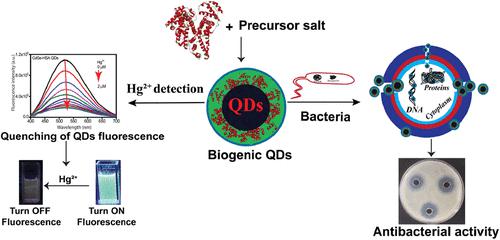当前位置:
X-MOL 学术
›
ACS Appl. Nano Mater.
›
论文详情
Our official English website, www.x-mol.net, welcomes your
feedback! (Note: you will need to create a separate account there.)
CdSe Core and CdSe@ZnSe Core–Shell QDs Decorated with Human Serum Albumin: Deciphering the Antimicrobial Properties and Sensing of Mercury Ion
ACS Applied Nano Materials ( IF 5.3 ) Pub Date : 2024-03-20 , DOI: 10.1021/acsanm.4c00149
Mahabul Haque 1 , Amarjyoti Mondal 1 , Sona Lyndem 1 , Dipak Chamlagai 2 , Atanu Singha Roy 1
ACS Applied Nano Materials ( IF 5.3 ) Pub Date : 2024-03-20 , DOI: 10.1021/acsanm.4c00149
Mahabul Haque 1 , Amarjyoti Mondal 1 , Sona Lyndem 1 , Dipak Chamlagai 2 , Atanu Singha Roy 1
Affiliation

|
In recent decades, Cd-based quantum dots (QDs) have gained tremendous interest as luminescence tags for numerous biological applications. However, chemical synthesis using organic molecules to encapsulate the QDs surface is a highly complex process, high-cost and aggressive fabrication, and less aqueous and biocompatible, which leads to restricted biological applications. In this paper, we have reported the biogenic synthesis of CdSe-HSA core and CdSe@ZnSe-HSA core–shell QDs for the first time using human serum albumin protein as a surface engineering molecule. The biosynthesized QDs were found to be smaller in size (2–3.5 nm) and highly aqueous compatible (stable for up to 150 days). The biosynthesized QDs act as ultrasensitive fluorescence probes for label-free sensing of Hg2+ with enhanced efficiency, and an LOD value of 1.3 nM for CdSe@ZnSe-HSA QDs (concentration range: 0–2 μM) was obtained and were also able to detect with the naked eye. A dynamic quenching mechanism was observed for the fluorescence quenching of the biosynthesized QDs by Hg2+ ions, and affinity toward the formation of Hg–Se or Hg–SH with the QDs provided the unique selectivity. Moreover, the smaller size and unique surface properties of the biosynthesized QDs contributed to the enhanced antibacterial properties against Gram-positive (S. aureus) and Gram-negative (E. coli) bacteria and found more effective against Gram-negative bacteria. This work implies the biogenic aqueous compatible synthesis of core and core–shell QDs for biological and environmental monitoring analytical methods for the development of bionanotechnology.
中文翻译:

人血清白蛋白修饰的 CdSe 核和 CdSe@ZnSe 核壳量子点:破译汞离子的抗菌特性和传感
近几十年来,基于镉的量子点(QD)作为众多生物应用的发光标签引起了极大的兴趣。然而,使用有机分子封装量子点表面的化学合成是一个高度复杂的过程、高成本和高强度的制造,并且水性和生物相容性较差,这导致生物应用受到限制。在本文中,我们首次报道了使用人血清白蛋白作为表面工程分子生物合成CdSe-HSA核和CdSe@ZnSe-HSA核壳量子点。生物合成的量子点尺寸更小(2-3.5 nm),并且具有高度水相容性(稳定期长达 150 天)。生物合成的量子点可作为超灵敏荧光探针,用于 Hg 2+的无标记传感,效率更高,CdSe@ZnSe-HSA 量子点的 LOD 值为 1.3 nM(浓度范围:0–2 μM),并且能够用肉眼来检测。观察到 Hg 2+离子对生物合成量子点的荧光猝灭的动态猝灭机制,并且与量子点形成 Hg-Se 或 Hg-SH 的亲和力提供了独特的选择性。此外,生物合成的量子点较小的尺寸和独特的表面特性有助于增强对革兰氏阳性菌(金黄色葡萄球菌)和革兰氏阴性菌(大肠杆菌)的抗菌性能,并且对革兰氏阴性菌更有效。这项工作意味着核和核壳量子点的生物水相容合成,用于生物和环境监测分析方法,以促进生物纳米技术的发展。
更新日期:2024-03-20
中文翻译:

人血清白蛋白修饰的 CdSe 核和 CdSe@ZnSe 核壳量子点:破译汞离子的抗菌特性和传感
近几十年来,基于镉的量子点(QD)作为众多生物应用的发光标签引起了极大的兴趣。然而,使用有机分子封装量子点表面的化学合成是一个高度复杂的过程、高成本和高强度的制造,并且水性和生物相容性较差,这导致生物应用受到限制。在本文中,我们首次报道了使用人血清白蛋白作为表面工程分子生物合成CdSe-HSA核和CdSe@ZnSe-HSA核壳量子点。生物合成的量子点尺寸更小(2-3.5 nm),并且具有高度水相容性(稳定期长达 150 天)。生物合成的量子点可作为超灵敏荧光探针,用于 Hg 2+的无标记传感,效率更高,CdSe@ZnSe-HSA 量子点的 LOD 值为 1.3 nM(浓度范围:0–2 μM),并且能够用肉眼来检测。观察到 Hg 2+离子对生物合成量子点的荧光猝灭的动态猝灭机制,并且与量子点形成 Hg-Se 或 Hg-SH 的亲和力提供了独特的选择性。此外,生物合成的量子点较小的尺寸和独特的表面特性有助于增强对革兰氏阳性菌(金黄色葡萄球菌)和革兰氏阴性菌(大肠杆菌)的抗菌性能,并且对革兰氏阴性菌更有效。这项工作意味着核和核壳量子点的生物水相容合成,用于生物和环境监测分析方法,以促进生物纳米技术的发展。

































 京公网安备 11010802027423号
京公网安备 11010802027423号